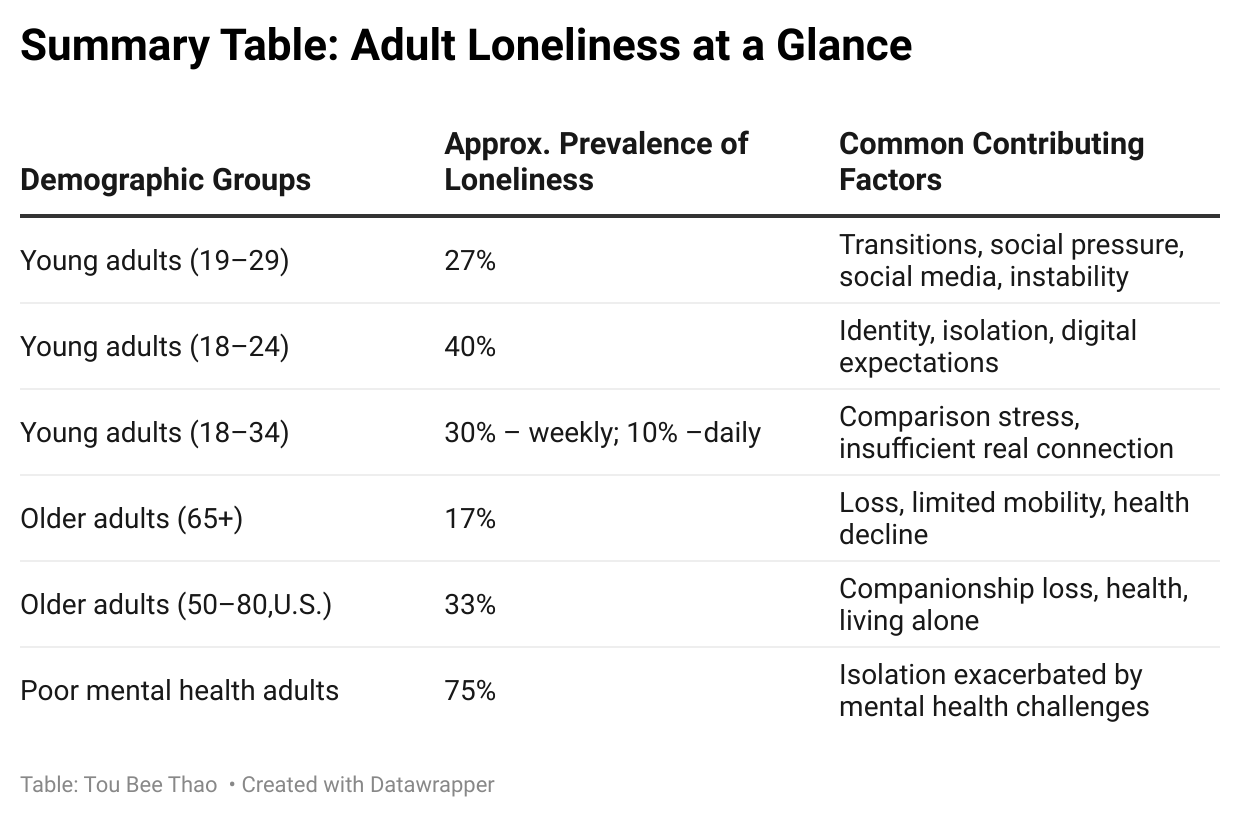Prevalence: How Many Adults Feel Lonely?
Global Snapshot
A Meta-Gallup survey across 142 countries found that 24% of individuals aged 15 and older report feeling very or fairly lonely CNN.
Gallup’s 2023 World Poll reported that 23% of people globally felt lonely "a lot of the day yesterday" Gallup.com.
This suggests that roughly 1 in 4 adults worldwide regularly experience loneliness.
By Age Group
Young Adults (19–29): About 27% report feeling very or fairly lonely CNN.
Older Adults (65+): The rate drops to 17%, the lowest among age groups CNN.
U.S. Adults Overall: Around 31% report feeling lonely, per one 2021 survey Statista.
By Age (Other Data):
18–24: Up to 40% admit feeling lonely often Wikipedia.
Young Adults (18–34): About 30% feel lonely at least once a week; 10% feel lonely daily AlumaCare.
Older Adults (50–80): In the U.S., about 33% reported lacking companionship some or all of the time in 2024 PMCReddit.
Why Are Adults Feeling Lonely?
Key Risk Factors:
Age & Life Stage
Adolescents and young adults face loneliness from transitions, social pressure, and identity struggles AlumaCareCNN.
Older adults often experience loneliness due to losses (e.g., spouse, friends), declining health, limited mobility, or living alone WikipediaPMCReddit.
Marital/Partner Status & Living Arrangement
Being single, widowed, or divorced correlates with higher loneliness; strong, supportive partnerships can be protective. Emotional quality of relationships matters, not just marital status PMC.
Living alone elevates loneliness, especially in older age PMCWikipedia.
Health Challenges
Poor physical and mental health are strongly tied to loneliness. Adults with poor mental health see much higher rates (up to 75%) than their healthier peers PMCRedditWhats the Big Data.
Socioeconomic Factors
Lower income and financial stress increase vulnerability; single adults (39%) report loneliness more than married (22%) AlumaCareGrateful Care ABA.
Social Disconnection & Cultural Shifts
The “friendship recession”—a notable decline in close friendships—leaves many with shallow or few relationships Wikipedia.
Overreliance on social media can distort connections and amplify feelings of disconnection AlumaCareNew York Post.
Marginalization & Stigma
Older immigrants, LGBTQ+ individuals, and others facing social stigma often experience heightened loneliness due to exclusion, language barriers, or weakened support networks Wikipedia+1Verywell Mind.
Global and Cultural Shifts
In Africa, rapid urbanization and erosion of traditional community bonds have raised loneliness—especially among adolescents The Guardian.
Conclusion
Scope: Loneliness is a global issue affecting around 1 in 4 adults, with peaks among young and older age groups.
Causes: It stems from a mix of life transitions, health challenges, social context, cultural shifts, and individual circumstances.
Why It Matters: Loneliness isn’t a trivial feeling—it’s tied to serious mental and physical health risks, warranting attention at personal and policy levels.


